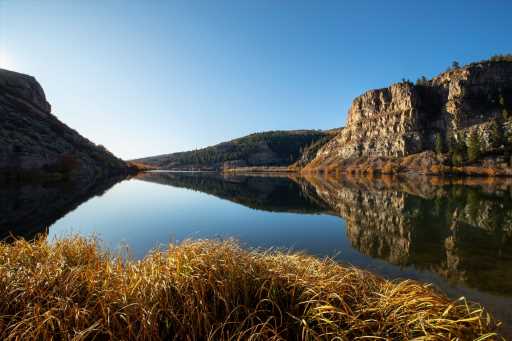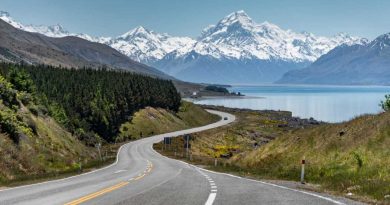Colorado’s next state park is beautiful, but will neighbors approve?
Eighteen months after the White River National Forest acquired a scenic and historic property 12 miles north of Glenwood Canyon at the doorstep of the remote Flat Tops Wilderness, officials are moving forward with plans to make it Colorado’s 43rd state park.
The 488-acre Sweetwater Lake property encompasses Colorado’s third-largest natural lake, which is framed by limestone cliffs. It currently offers limited camping, hiking, horseback riding and fishing provided by a commercial outfitter which operated there for decades when the property was privately owned. But forest officials and Colorado Parks and Wildlife see it as a gem with untapped potential, saying their goal is to improve access and modernize antiquated facilities without altering the rustic character of the site.
But before tapping that potential, they’ll have to repair the relationship with locals, who were blindsided in October 2021 when Gov. Jared Polis held a media event to announce that Sweetwater Lake would become a state park.
White River forest supervisor Scott Fitzwilliams acknowledges that mistakes were made early in the planning process. “I have been really open about how I messed up, about lack of communication with our partners and communities,” he said. “The governor announced it and we didn’t communicate with the locals and the county commissioners. That was a big mistake.
“We failed to treat our partners and our communities the way they are accustomed. That caused quite the backlash,” he continued. “People immediately thought of big-time state parks, and that’s not the vision. We’ve had to do a lot of backtracking on that.”
Plans for a state park got underway in October 2019 when the environmental nonprofits Eagle Valley Land Trust and the Conservation Fund formed the Save the Lake Campaign in an effort to prevent private development on the land. The Conservation Fund bought the property eight months later and then sold it to the forest service in September 2021.
“When the opportunity arose to purchase it, we were pretty excited because you just don’t come across properties like that with this much water, a lake, the ecological things, the historical and cultural aspects of it,” Fitzwilliams said. “The sky is the limit for what you can offer there, but we always tempered that. Our vision has always been something intimate, unique and (developed) in a manner that really takes into account and preserves the values that have been around there for so long. We have lots of places that are overrun with people, so we don’t need another one.”
But Garfield County commissioner Tom Jankovsky said the community “is still upset” and feels its voice is not being heard.
“It just seems like the forest service and the state are trying to move this through,” Jankovsky said. “We’d like to see a full EIS (environmental impact statement). Right now that land is pretty much wildlife habitat. This is a big change. The citizens really need to have that chance to be involved, and the forest service needs to listen. It doesn’t need to be predetermined. It sounds very much like this is predetermined.”
Bergen Tjossem, deputy director of the Eagle Valley Land Trust, estimates that less than 100 people live close to Sweetwater Lake and said there have meetings with local residents every other week since the fall. He is sensitive to their concerns.
“I think it’s natural to have these sorts of concerns about a place that people really, really care about, and have enjoyed for generations,” Tjossem said. “We have this incredible opportunity. We’ve got the forest service owning the property, and we’ve got Colorado Parks and Wildlife with their immense capacity to manage recreational areas coming in as the management partner.
“There’s no other agency in Colorado that manages crowds and manages people and protects natural resources the way CPW can,” he continued. “They know how to enforce laws and create regulations to protect the site and make sure it’s not overrun.”
According to a vision statement on the Eagle Valley Land Trust website, the partnership has three primary goals: Improve access and “modernize” the property’s facilities while providing recreational opportunities appropriate for the setting; protect existing characteristics of the area; and consider public input while honoring the site’s “historical legacy.”
The EVLT site has answers for frequently asked questions about the project and links to a virtual public information meeting which the partnership conducted on March 6.
The property provides habitat for bald eagles, osprey, elk and deer. Currently there are a dozen old buildings including a boat house, a barn, some cabins and a campground with nine campsites. The Flat Tops Wilderness is only a short hike away.
“Whatever we do there, we want to maintain that peaceful, easy feeling, that sense of place, that culture, that history,” Fitzwilliams said.
The forest service, CPW and the Eagle Valley Land Trust this spring are expected to finalize a proposed management plan that would then go through a mandatory National Environmental Policy Act process, most likely this summer. That process will include opportunities for public comment. After the NEPA process is completed, Fitzwilliams will make a final decision.
It’s likely that hiking, camping, horseback riding, fishing, wildlife watching, picnics, ice fishing, snowshoeing and “hand-launched watercraft” such as stand-up paddling and kayaking will be allowed when Sweetwater becomes a state park, according to a power-point presentation shown at the public information meeting three weeks ago. Swimming, off-road biking, motorized recreation, rock climbing and dispersed camping are not likely to be allowed. The site also has the potential for designation as an official dark-sky destination.
“We used $7.5 million of the taxpayers’ money to purchase this as a recreation facility,” Fitzwilliams said. “It’s got to be a functional recreation site. That doesn’t mean it has to be a 150-site campground with big day-use areas and special events. It can be a very unique niche kind of experience. There’s a wide spectrum of things we can do. What is the feeling, the history and the culture that was there for 40-50 years? How do we keep some of that there?”
“This forest experiences 17.8 million visitors a year, which is up 5 million visitors from five years ago,” Fitzwilliams said. “Our staffing levels and infrastructure and funding are just not enough to keep up with these demands. That was the whole impetus of, ‘Let’s get a partner to help us.’ ”
Subscribe to our weekly newsletter, The Adventurist, to get outdoors news sent straight to your inbox.
Source: Read Full Article






